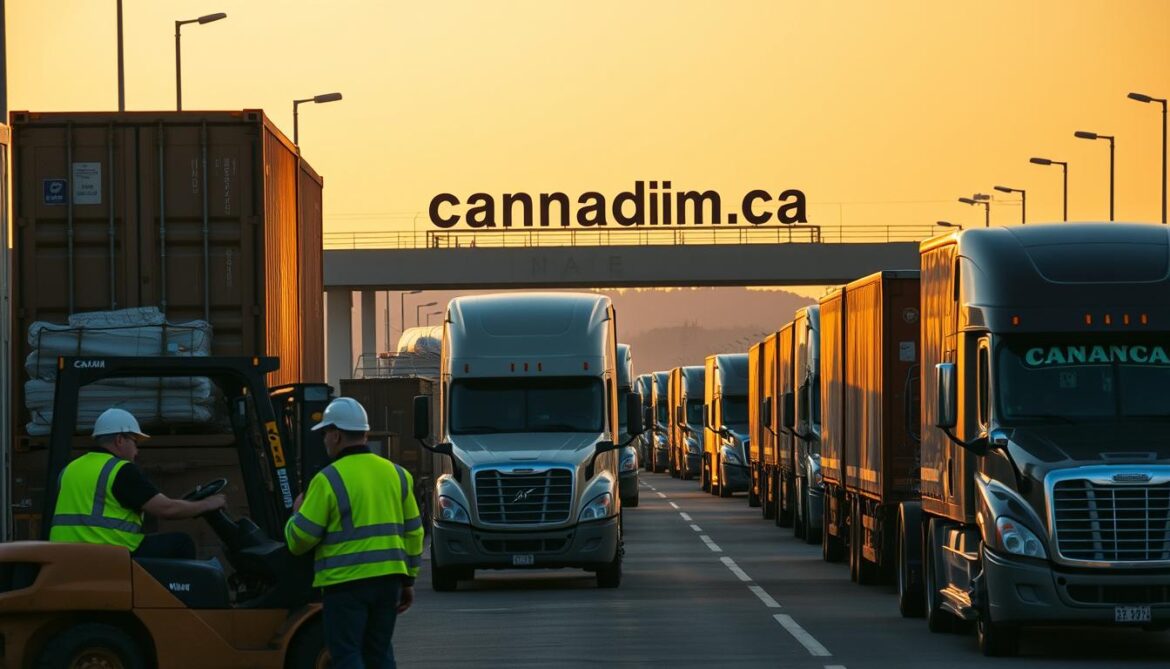Many Canadian small businesses miss out on international trade chances. They think it’s too complex. Yet, Canada imported goods worth over $631 billion in 2023. This shows huge potential for businesses ready to explore.
Importing products can lead to unique inventory and better pricing. It can also expand your business horizons. But import rules can be tricky without proper guidance.
To start importing, you need a Business Number with an import/export account. The Canada Revenue Agency provides this for free. It usually takes just minutes to get.
This guide covers all you need to know about bringing goods into Canada. We’ll explain the legal parts and customs procedures. You’ll find practical info to make importing easier.
This resource helps both new and experienced importers. It shows how to avoid common mistakes. You’ll learn best practices for efficient and lawful importation into Canada.
The Fundamentals of Canadian Importation
Successful importing into Canada starts with understanding key concepts and market trends. Businesses need a Business Number (BN) from the Canada Revenue Agency for import/export accounts. This BN is your official identifier for all importation processes.
Definition and Scope of International Trade
International trade involves exchanging capital, goods, and services across borders. For Canadian businesses, importation means bringing foreign-made goods into Canada for commercial use.
This global movement of goods creates economic opportunities. It also requires following set regulations. Knowing these basics helps businesses navigate global commerce while following Canadian laws.
Key Statistics on Canadian Import Market
Canada has a strong import market that boosts its economy. Canadian imports exceed $500 billion yearly. This shows Canada’s deep connection with global supply chains.
Major Import Categories
Canada imports various goods, with some categories standing out. Machinery and equipment top the list. Automotive vehicles and parts follow closely. Electronics, pharmaceuticals, and consumer goods are also major imports.
Primary Trading Partners
The United States is Canada’s biggest trading partner, providing about 50% of imports. China comes second, with Mexico and the European Union following. CUSMA (formerly NAFTA) shapes North American trade rules.
Knowing these import basics helps businesses plan for international trade. This knowledge helps create effective import strategies that follow market trends and rules.
Legal Framework Governing Importation in Canada
Canadian businesses must follow complex laws when importing goods. These rules ensure proper trade while protecting national interests. Understanding these laws is crucial to avoid penalties and delays.
Failure to comply can result in fines or criminal charges. These could significantly impact your business operations.
The Customs Act and Its Requirements
The Customs Act is the foundation of Canada’s import regulations. It outlines key requirements for legally bringing goods into the country.
The Act sets protocols for important import processes. These include reporting goods, document standards, and valuation methods for customs duties.
- Proper reporting of imported goods
- Documentation standards and retention requirements
- Valuation methods for determining customs duties
- Payment procedures for applicable taxes and duties
Compliance with the Customs Act is mandatory for importers. Border officials can examine, detain, and seize non-compliant goods.
Violations may result in monetary penalties through the Administrative Monetary Penalty System (AMPS).

Criminal Code Provisions Related to Import Violations
Serious import violations may lead to criminal proceedings under Canada’s Criminal Code. These laws add another layer of enforcement to ensure compliance.
Smuggling Offenses and Penalties
Smuggling is bringing goods into Canada without reporting them or paying duties. It’s a serious offense under the Criminal Code.
Penalties for smuggling can include heavy fines and imprisonment. Offenders may also lose their imported goods and import privileges.
- Fines up to three times the value of the smuggled goods
- Imprisonment for up to five years
- Permanent seizure of the imported merchandise
- Revocation of import privileges
Even unintentional smuggling can have significant consequences. This highlights the importance of knowing import requirements thoroughly.
Fraudulent Documentation Consequences
Providing false information on import documents is another serious violation. Fraudulent practices can result in severe penalties.
- Falsifying certificates of origin to avoid duties
- Misrepresenting goods’ value on commercial invoices
- Providing incorrect product descriptions to evade restrictions
These actions can lead to fines, criminal prosecution, and imprisonment. Your business reputation may also suffer irreparable damage.
“Compliance is not merely about following rules—it’s about establishing a sustainable foundation for international trade operations that protects both your business interests and Canada’s economic integrity.”
Regulatory Bodies Overseeing Canadian Imports
Several government agencies enforce import regulations in Canada. The Canada Border Services Agency (CBSA) is the primary enforcement authority.
Many imported goods must meet requirements from multiple agencies. These may include specific permits, certificates, or inspections.
- Canadian Food Inspection Agency (CFIA) – Oversees food, plant, and animal imports
- Health Canada – Regulates pharmaceuticals, medical devices, and consumer products
- Global Affairs Canada – Manages controlled goods and implements trade agreements
- Environment and Climate Change Canada – Monitors environmentally sensitive imports
Each agency has specific requirements your business must meet. Non-compliance can cause shipment delays, extra costs, or legal issues.
Understanding these laws is key to effective import strategies. Work with customs professionals to navigate Canada’s import requirements successfully.
Canadian Customs Classification System
Canada’s Customs Classification System is vital for international trade businesses. It determines customs duties, permit requirements, and product restrictions. Understanding this system can improve your profits and border crossings.
Harmonized System (HS) Codes Explained
The Harmonized System classifies traded products globally. HS codes have six digits used by over 200 countries. Canada adds four more digits, creating a 10-digit code for imports.
These codes organize products into categories and subcategories. The first six digits form the international code. Canada’s extra four digits specify tariffs and regulations.
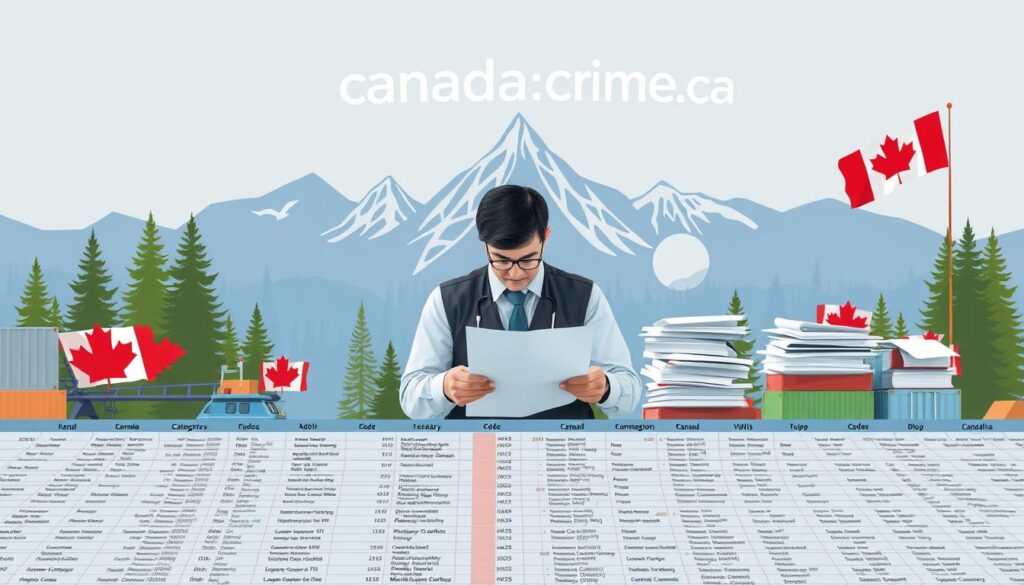
Tariff Classification of Goods
Proper tariff classification means assigning the right HS code to imported goods. This is based on their makeup, purpose, and features. Classification determines duty rates, taxes, and regulations.
How to Determine Correct Classification
To classify products accurately, gather details on composition, function, and manufacturing. Get product samples when possible. Physical examination often clarifies classification questions.
For complex items, check the Canadian Customs Tariff and previous rulings. If unsure, request an advance ruling from the Canada Border Services Agency (CBSA).
Consequences of Misclassification
Wrong classification can lead to serious problems for your business. These include reassessment of duties, taxes with interest, and fines. In severe cases, goods may be seized.
Misclassification often triggers import compliance audits, disrupting operations. It can damage your reputation with customs authorities. Proper classification protects your supply chain and business.
Import Duties and Taxes Structure
Importing goods into Canada involves a complex system of financial obligations. These include customs duties, federal taxes, and provincial levies. Understanding these costs is vital for accurate budgeting and regulatory compliance.
Financial aspects of importation can greatly affect your business’s profits. Careful planning is necessary to manage these costs effectively.
Understanding Customs Duties and Tariffs
Customs duties are taxes on goods entering Canada. They’re based on product classification, origin, and value. These tariffs vary widely depending on the product and its source country.
Products from countries with Canadian trade agreements often get lower duty rates. For instance, goods from CUSMA countries may have reduced or zero duties.
The customs duties calculation typically follows this formula:
- Duty = Customs Value × Applicable Tariff Rate
- Customs Value = Price paid for goods + shipping costs + insurance
Goods and Services Tax (GST) on Imports
The federal Goods and Services Tax applies to most imported goods at 5%. Unlike duties, GST applies uniformly with few exceptions.
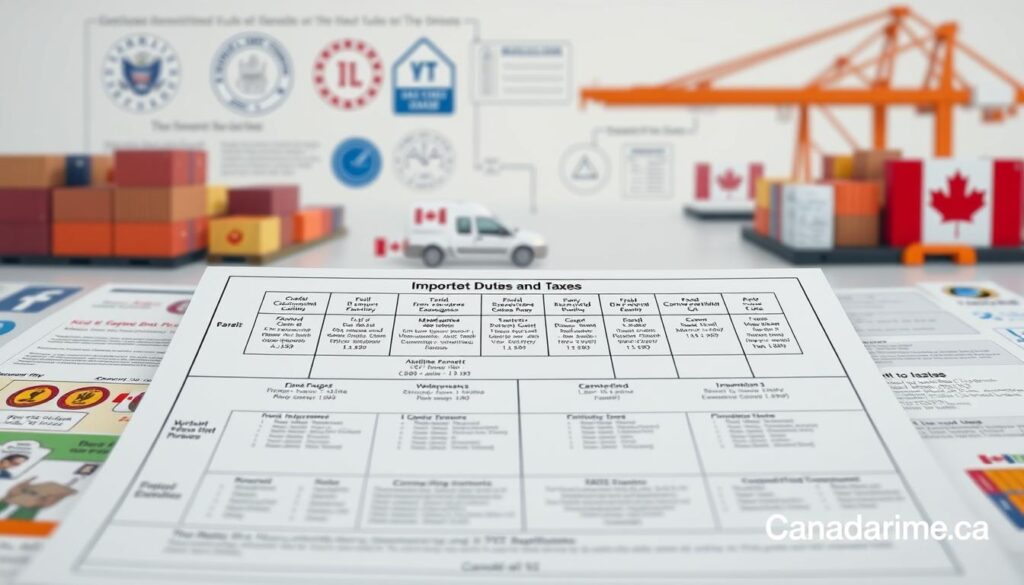
GST is calculated on the duty-paid value of your imports. This includes the customs value, applicable duties, and other Customs Tariff taxes.
- The customs value of the goods
- Any applicable duties
- Any other taxes levied under the Customs Tariff
The CBSA manages temporary GST/HST exemptions on certain imported goods. These apply to traveler, postal, courier, and commercial streams. Knowing these exemptions can save your business money.
Provincial Sales Tax Considerations
Provincial tax obligations add complexity to importing. Different provinces have unique approaches to taxing imported goods.
Harmonized Sales Tax (HST) Provinces
Some provinces use the Harmonized Sales Tax system. These include Ontario, New Brunswick, Nova Scotia, Prince Edward Island, and Newfoundland and Labrador.
In HST provinces, the provincial portion is collected with federal GST at importation. HST rates range from 13% to 15%, depending on the province.
The CBSA collects the full HST during customs clearance. This simplifies compliance for importers in these provinces.
Quebec Sales Tax (QST) Requirements
Quebec has its own tax system through the Quebec Sales Tax. Importers selling in Quebec must register for QST separately from GST.
The current QST rate is 9.975%, calculated on the GST-inclusive price. QST isn’t collected at the border. It must be self-assessed and paid to Revenu Québec.
Other provinces like British Columbia, Saskatchewan, and Manitoba have separate sales tax systems. These may apply to imported goods sold within those provinces. Understanding these regional tax differences is crucial for accurate financial planning.
Essential Documentation for Successful Importation
Proper documentation is crucial for smooth imports into Canada. It ensures legal compliance and prevents costly delays. Understanding the required documents is key to successful import operations.
The Canada Border Services Agency (CBSA) has specific requirements for import paperwork. Meeting these requirements is essential for efficient cross-border shipping.
Commercial Invoice Requirements
The commercial invoice is the primary document for Canadian imports. It must contain detailed information about the imported goods. This includes accurate product descriptions, quantities, and values.
The invoice must state the country of origin and terms of sale. Currency information is also required. The CBSA has specific formatting rules that must be followed.
Incomplete or inaccurate invoices often cause shipment delays at the border. Double-check all details to avoid these issues.
Bill of Lading and Air Waybills
These documents serve as receipts and contracts for goods transportation. They document ownership and responsibility throughout the shipping process.

These documents must accurately reflect the transported goods. They should include all relevant shipping details. This information must align with your commercial invoice.
Proper completion of these documents is crucial for import compliance. They form a critical link in your import chain.
Certificate of Origin and Other Supporting Documents
Certificates of Origin determine applicable duty rates on imports. Memorandum D11-4-2 outlines specific requirements for proof of origin. These must be met to qualify for preferential tariff treatment.
NAFTA/CUSMA Certificates
CUSMA certificates have specific requirements for imports from the US or Mexico. Proper completion is essential for claiming preferential tariff treatment. This helps avoid unnecessary duties.
Special Permits and Licenses
Many products require additional documentation for importation into Canada. This includes food products, pharmaceuticals, weapons, and certain textiles. Special permits must be obtained before starting the import process.
Some goods may be subject to measures under the Special Import Measures Act. This can include anti-dumping duties and countervailing duties. Identifying these requirements early can prevent complications during customs clearance.
The Complete Importation Process
Importing goods into Canada requires understanding the entire process from pre-arrival to post-entry requirements. Mastering each stage ensures smooth cross-border shipping and compliance with Canadian regulations. This approach helps businesses avoid costly delays and penalties.
Pre-Arrival Processing and Data Requirements
The Advance Commercial Information (ACI) program requires carriers to submit cargo data electronically before arrival. This step enables risk assessment before goods reach Canadian borders.
Timing requirements vary by transportation mode. Marine shipments need data submitted 24 hours before loading at the foreign port. Air shipments require information 4 hours prior to arrival or at departure for shorter flights.
Highway and rail carriers have specific timeframes to ensure efficient global logistics.
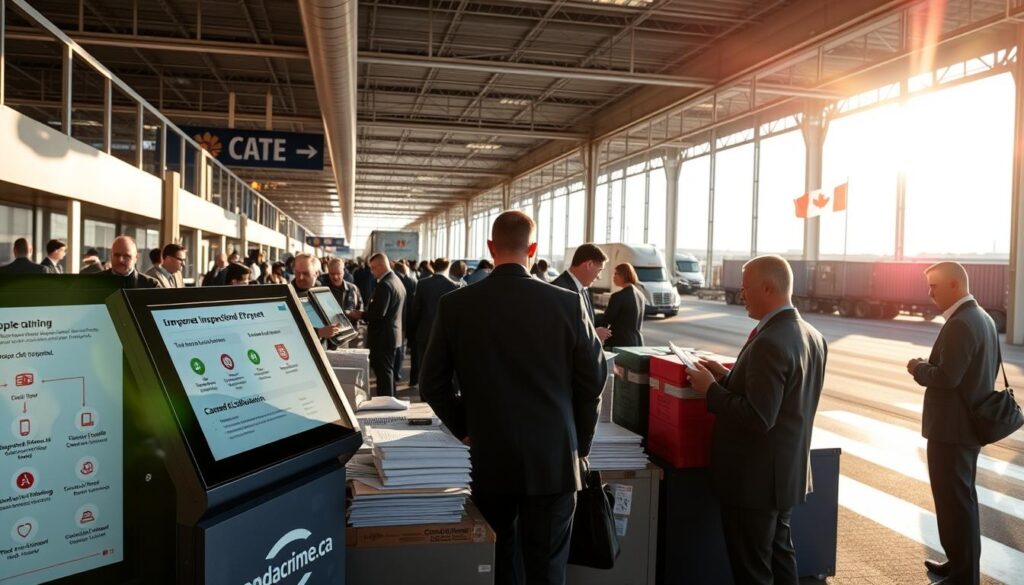
Customs Clearance Procedures
Once your shipment arrives in Canada, it must go through a structured clearance process:
- Reporting goods upon arrival at the port of entry
- Presenting required documentation including commercial invoices and certificates of origin
- Potential inspection of goods (if selected through risk assessment)
- Release of goods from CBSA control
- Payment of applicable duties and taxes
You can speed up this process using Electronic Data Interchange (EDI) or Release on Minimum Documentation (RMD). The CBSA Portal is another option. Each method offers different benefits based on your import volume and frequency.
Post-Entry Requirements and CBSA Audits
After goods are released, importers must complete accounting documentation within five business days. The CBSA may conduct post-release checks to ensure ongoing import compliance.
Record Keeping Obligations
Canadian laws require you to keep all import-related documents for six years from the importation date. This includes invoices, transportation documents, customs accounting papers, and correspondence with suppliers or customs authorities.
Self-Assessment and Voluntary Disclosures
The Voluntary Disclosures Program (VDP) lets importers correct previous errors without facing penalties. To qualify, your disclosure must be complete, voluntary, and involve potential penalties.
Proactive self-assessment shows good faith to regulators and can prevent serious compliance issues. Regular internal audits help spot potential problems before CBSA trade compliance checks.
Restricted and Prohibited Imports in Canada
Canada strictly controls certain imports. Some goods face restrictions, while others are entirely prohibited. Understanding these rules is vital for businesses in international trade.
The Canadian Border Services Agency (CBSA) enforces these restrictions. They aim to protect public safety, the environment, and the economy.
Controlled Substances and Dangerous Goods
Canada heavily regulates controlled substances and dangerous goods. Narcotics, explosives, and hazardous materials need special permits and handling procedures to cross the border.
These items fall under specific laws. Violations can lead to severe penalties.
- Substantial monetary fines
- Seizure and forfeiture of goods
- Criminal charges and potential imprisonment
- Suspension of import privileges
Agricultural and Food Products Restrictions
Canada restricts agricultural and food product imports. These rules protect Canada’s farming industry and ensure food safety.
The Canadian Food Inspection Agency (CFIA) oversees these imports. They focus on specific areas of concern.

Many farm products need import permits or inspections. Meat, dairy, produce, and plants face strict controls.
These rules prevent pests and diseases from entering the country. Compliance is crucial for importers.
“Ensuring compliance with agricultural import regulations is not just about following rules—it’s about protecting Canada’s food supply and agricultural economy for generations to come.”
Intellectual Property and Counterfeit Goods
Canada fiercely guards intellectual property rights at its borders. Customs officials seize and destroy counterfeit and pirated goods when found.
Border Enforcement of IP Rights
The CBSA works with rights holders to stop fake goods. Laws provide the framework for this enforcement.
Border officers can hold suspected counterfeit items. Rights holders can ask for help through a special program.
| Category | Examples of Prohibited Items | Governing Legislation | Enforcement Agency |
|---|---|---|---|
| Obscene Material | Child pornography, hate propaganda | Criminal Code of Canada | CBSA/RCMP |
| Consumer Goods | Used mattresses, certain used vehicles | Customs Tariff | CBSA |
| Controlled Substances | Narcotics, unauthorized pharmaceuticals | Controlled Drugs and Substances Act | Health Canada/CBSA |
| Counterfeit Goods | Fake branded merchandise, pirated media | Copyright Act, Trademarks Act | CBSA/Innovation, Science and Economic Development Canada |
Reporting Suspected Violations
You can report suspected IP violations to the CBSA Border Watch Line. This confidential service helps authorities fight illegal imports.
For more details on prohibited products, check the CBSA website. Staying informed about these rules is key to import compliance.
International Trade Agreements Affecting Canadian Importers
Trade agreements shape how Canadian businesses import goods and manage customs duties. These agreements can reduce costs and administrative burdens for importers. Preferential agreements now govern over 60% of Canada’s import activities, according to Canada’s international trade statistics.
CUSMA (Formerly NAFTA) Provisions
CUSMA replaced NAFTA in 2020, keeping many previous provisions while introducing important changes. Key modifications include updated automotive rules of origin, enhanced intellectual property protections, and streamlined certification procedures.
CUSMA gives importers more flexibility in certifying origin. You can create your own certification document with all required data elements. This self-certification approach reduces paperwork but requires careful attention to detail.
CETA and Other Major Trade Agreements
CETA eliminates tariffs on 98% of goods traded between Canada and the European Union. This agreement offers Canadian importers duty-free access to many European products.
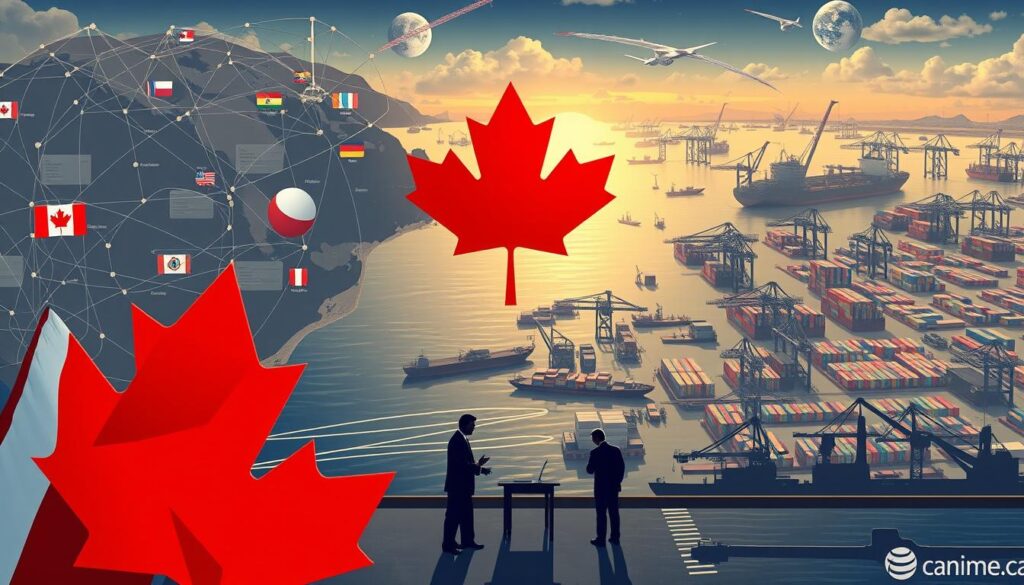
Other key agreements include the CPTPP and bilateral deals with South Korea, Chile, and Israel. Each agreement offers unique opportunities for tariff reduction and market access.
Preferential Tariff Treatments
Trade agreements enable preferential tariff treatments that can reduce or eliminate duties on qualifying imports. These benefits require careful compliance with specific rules and documentation requirements.
“Understanding preferential tariff treatments can mean the difference between profit and loss for many import operations, particularly for high-volume or high-duty goods.”
Rules of Origin Requirements
Rules of origin determine if goods qualify as “originating” from a partner country. These rules often involve substantial transformation criteria or regional value content thresholds.
Under CUSMA, many products must contain 60-75% North American content to qualify for preferential treatment. Each agreement has unique origin requirements, so analyze your supply chain carefully.
Documentation for Preferential Rates
Claiming preferential tariff rates requires proper documentation, which varies by agreement. Most often, you’ll need a certificate or statement of origin verifying compliance.
Keep these documents in your records for at least five years after importation. Regular internal audits of your origin documentation can help prevent issues during CBSA verifications.
By using these trade agreements wisely, Canadian importers can gain cost advantages and compete better globally.
Supply Chain Management for Effective Importation
A well-organized supply chain is crucial for Canadian importers in today’s competitive market. It ensures smooth goods flow while minimizing costs and risks. Understanding supply chain management basics is vital for cross-border commerce.
Logistics Planning and Optimization
Choosing the right transportation mode is key to efficient logistics planning. Each option has unique advantages based on your needs.
| Transport Mode | Cost Level | Speed | Best For | Limitations |
|---|---|---|---|---|
| Ocean Freight | Low | Slow (20-60 days) | Bulk, non-urgent goods | Weather delays, port congestion |
| Air Freight | High | Fast (1-5 days) | Urgent, high-value items | Capacity constraints, cost |
| Rail | Medium | Medium (5-15 days) | Heavy goods, inland transport | Limited route flexibility |
| Truck | Medium-High | Medium (1-10 days) | Regional distribution | Border delays, driver shortages |
Consolidating shipments and optimizing container use can greatly reduce transportation costs. Using Transportation Management Systems can improve route planning and track carrier performance.
Inventory Management Strategies
Importing goods requires special inventory approaches due to extended lead times. Traditional just-in-time methods often need changes when sourcing internationally.
Analyze demand patterns and lead time variability to calculate proper safety stock levels. For Canadian importers, consider seasonal factors like winter weather disruptions in inventory planning.
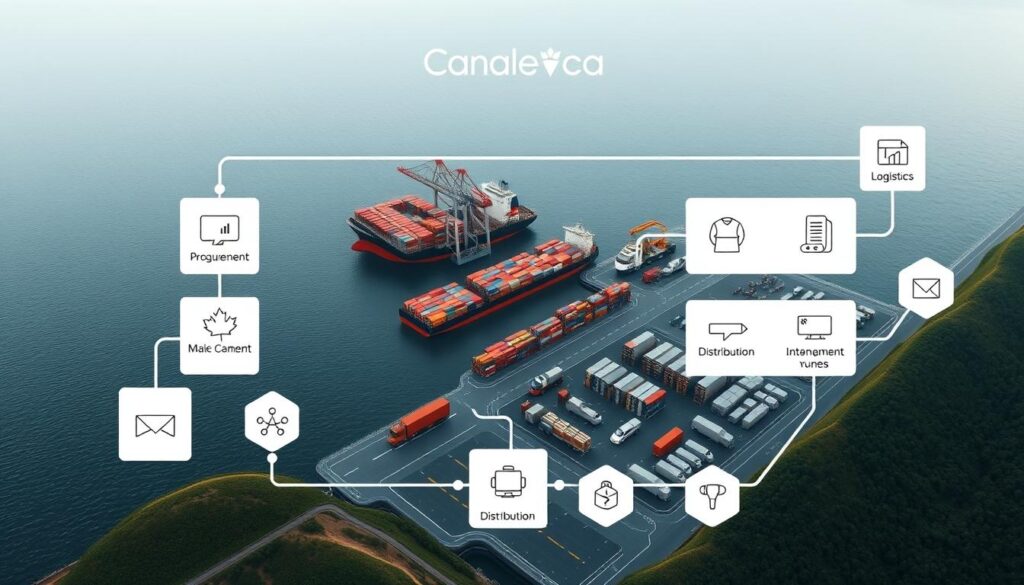
Demand forecasting is crucial when dealing with cross-border shipping. Advanced analytics tools can predict seasonal changes and market trends affecting import needs.
Risk Mitigation in Global Supply Chains
Diversifying suppliers across multiple countries provides resilience against regional disruptions. Many Canadian importers maintain relationships with suppliers in different regions to ensure continuity.
Regular supply chain vulnerability checks help identify potential weak points early. Map your entire supply network and evaluate each link for possible failure points.
Addressing Disruptions and Delays
Create specific plans for common issues like port congestion, customs holds, and transportation disruptions. Set up alternative routing options and backup suppliers for critical components.
Include expedited shipping in your disruption management toolkit. Though costlier, it can prevent production shutdowns or missed customer commitments.
Insurance Considerations
Beyond basic cargo insurance, consider coverage for delays, general average, and business interruption. Customs bonds are essential for Canadian importers to guarantee duty and tax payments.
A comprehensive risk management approach combines proper insurance with proactive supply chain strategies. This protects your business from uncertainties in global trade.
Working with Customs Brokers and Freight Forwarders
Partnering with skilled customs brokers and freight forwarders can revolutionize your Canadian imports. These experts handle import compliance complexities, letting you focus on core business activities.
Their expertise can prevent costly delays and ensure smooth operations. They’re vital allies in navigating the intricate world of international trade.
Selecting the Right Partners
Choosing the best customs and logistics partners requires thorough evaluation. Consider these key factors when selecting collaborators for your global logistics needs:
- Industry experience with your specific product categories
- Geographic expertise in your source markets
- Technological capabilities and integration options
- Size and service scope relative to your business needs
- Reputation among similar importers
Ask for references from clients with similar import profiles. Evaluate their communication responsiveness before making your final decision.

Services Offered by Customs Professionals
CBSA-licensed customs brokers offer specialized services to streamline your importation process. These typically include:
- Obtaining release of imported goods at the border
- Accurate tariff classification and valuation assistance
- Payment of applicable duties and taxes
- Documentation preparation and submission
- Record maintenance and CBSA audit representation
Freight forwarding professionals add value with carrier selection and cargo consolidation. They also provide warehousing solutions and comprehensive distribution arrangements.
Effective customs management isn’t just about compliance—it’s a strategic advantage that can significantly impact your bottom line.
Cost Considerations and ROI
Engaging customs professionals involves fees, but the return on investment is substantial. The value comes through:
- Reduced duties through proper classification
- Fewer delays and penalty avoidance
- Time savings for your internal staff
- Strategic advice on import optimization
Many businesses find that expert guidance outweighs service fees. This is especially true given the complexity of Canadian import regulations.
The potential costs of non-compliance make professional help a smart investment. Their expertise can save you money and headaches in the long run.
Technology Solutions for Import Compliance and Data Management
Digital tools are revolutionizing import compliance and data management for Canadian businesses. These solutions streamline processes, minimize errors, and ensure regulatory compliance. The right tech stack can turn import operations into a competitive edge.
Electronic Data Interchange (EDI) Systems
EDI systems form the core of modern import operations. They enable direct computer-to-computer exchange of standardized business documents. This eliminates manual data entry and creates digital connections between your company and trade partners.
The CBSA’s EDI program supports various customs transactions. These include cargo and release info, accounting documents, and duty payments. It also covers commercial import declarations.
EDI technology offers faster customs clearance and fewer data entry errors. It also improves visibility across your import supply chain. Many importers report a 40% reduction in document processing time after implementation.
Import Management Software Options
Various software solutions are available for managing import compliance and documentation. These range from comprehensive Global Trade Management platforms to specialized ERP modules. Cloud-based solutions have made these tools accessible to businesses of all sizes.
Effective import management software includes features for automated product classification and duty calculation. It also offers document management, compliance reporting, and supply chain analytics. When choosing software, consider how it fits with your systems and supports CARM.
Blockchain Applications in International Trade
Blockchain is transforming global logistics and international trade. It creates unchangeable, transparent records of transactions and documents. This technology can reduce fraud and speed up verification processes.
Digital Documentation
Blockchain-based digital documentation provides trusted, tamper-proof records. This can speed up customs clearance and simplify compliance checks. It creates a single source of truth for all trade documents.
Benefits include reduced document fraud risk and faster verification. It also improves collaboration between stakeholders and enhances audit capabilities.
Traceability Solutions
Traceability solutions offer end-to-end visibility of products from manufacturer to delivery. They support compliance with origin requirements and help respond to quality issues. These tools track product movements, conditions, and handling throughout the import journey.
| Technology Solution | Primary Benefits | Implementation Complexity | Best For |
|---|---|---|---|
| EDI Systems | Faster clearance, reduced errors | Medium | Regular importers with high volume |
| GTM Software | Comprehensive compliance management | High | Large enterprises with diverse imports |
| Cloud Import Solutions | Accessibility, lower upfront costs | Low | Small to medium businesses |
| Blockchain Systems | Document security, traceability | High | Companies with complex supply chains |
Investing in the right tech solutions can boost import compliance and cut costs. The CBSA is expanding its digital services. This makes it crucial for importers to adopt compatible technologies that work with government systems.
Conclusion: Building a Successful Importation Strategy
Canadian import regulations require a smart approach. Research your product requirements and understand the rules for your goods. This helps prevent costly delays and penalties at the border.
Build strong relationships with suppliers, customs brokers, and freight forwarders. These partnerships provide valuable expertise and help solve problems quickly. They create a support network for smooth international trade.
Use programs offered by Canada Border Services Agency. Customs Self-Assessment (CSA), Partners in Protection (PIP), and Free and Secure Trade (FAST) can reduce border delays. These programs also help cut down on paperwork.
Train your staff on importation procedures and changing regulations. Ongoing education is crucial in the ever-changing world of international trade. It gives your business a competitive edge.
Set up strong compliance processes and documentation systems. Regularly review your importation practices to find ways to improve. This can help reduce costs and boost efficiency.
A good importation strategy opens doors to global opportunities. It helps maintain regulatory compliance while giving you an edge in the Canadian market. With these steps, you can turn importation into a business advantage.

